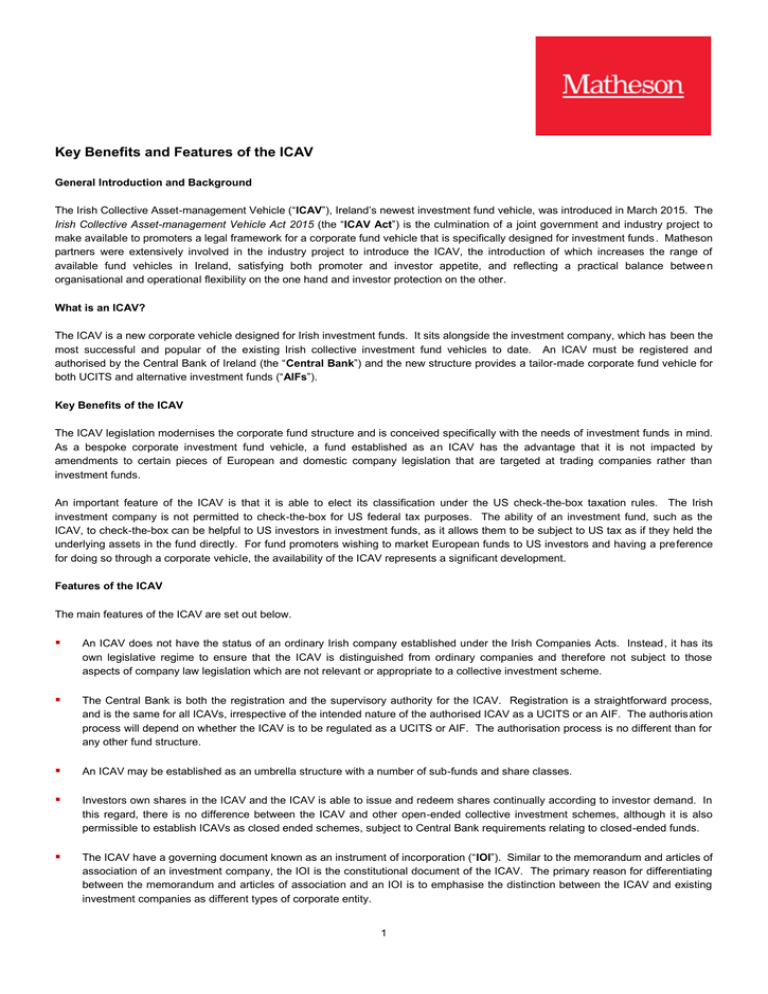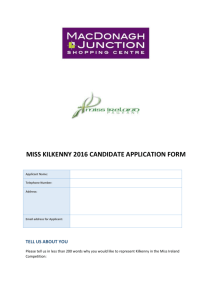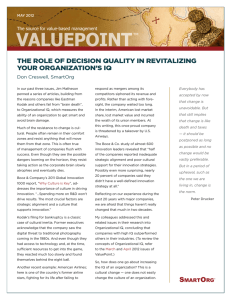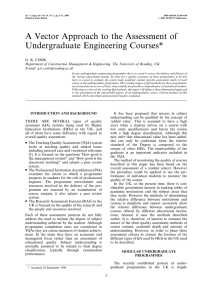Key Benefits and Features of the ICAV | Matheson
advertisement

Key Benefits and Features of the ICAV General Introduction and Background The Irish Collective Asset-management Vehicle (“ICAV”), Ireland’s newest investment fund vehicle, was introduced in March 2015. The Irish Collective Asset-management Vehicle Act 2015 (the “ICAV Act”) is the culmination of a joint government and industry project to make available to promoters a legal framework for a corporate fund vehicle that is specifically designed for investment funds. Matheson partners were extensively involved in the industry project to introduce the ICAV, the introduction of which increases the range of available fund vehicles in Ireland, satisfying both promoter and investor appetite, and reflecting a practical balance betwee n organisational and operational flexibility on the one hand and investor protection on the other. What is an ICAV? The ICAV is a new corporate vehicle designed for Irish investment funds. It sits alongside the investment company, which has been the most successful and popular of the existing Irish collective investment fund vehicles to date. An ICAV must be registered and authorised by the Central Bank of Ireland (the “Central Bank”) and the new structure provides a tailor-made corporate fund vehicle for both UCITS and alternative investment funds (“AIFs”). Key Benefits of the ICAV The ICAV legislation modernises the corporate fund structure and is conceived specifically with the needs of investment funds in mind. As a bespoke corporate investment fund vehicle, a fund established as an ICAV has the advantage that it is not impacted by amendments to certain pieces of European and domestic company legislation that are targeted at trading companies rather than investment funds. An important feature of the ICAV is that it is able to elect its classification under the US check-the-box taxation rules. The Irish investment company is not permitted to check-the-box for US federal tax purposes. The ability of an investment fund, such as the ICAV, to check-the-box can be helpful to US investors in investment funds, as it allows them to be subject to US tax as if they held the underlying assets in the fund directly. For fund promoters wishing to market European funds to US investors and having a preference for doing so through a corporate vehicle, the availability of the ICAV represents a significant development. Features of the ICAV The main features of the ICAV are set out below. An ICAV does not have the status of an ordinary Irish company established under the Irish Companies Acts. Instead, it has its own legislative regime to ensure that the ICAV is distinguished from ordinary companies and therefore not subject to those aspects of company law legislation which are not relevant or appropriate to a collective investment scheme. The Central Bank is both the registration and the supervisory authority for the ICAV. Registration is a straightforward process, and is the same for all ICAVs, irrespective of the intended nature of the authorised ICAV as a UCITS or an AIF. The authorisation process will depend on whether the ICAV is to be regulated as a UCITS or AIF. The authorisation process is no different than for any other fund structure. An ICAV may be established as an umbrella structure with a number of sub-funds and share classes. Investors own shares in the ICAV and the ICAV is able to issue and redeem shares continually according to investor demand. In this regard, there is no difference between the ICAV and other open-ended collective investment schemes, although it is also permissible to establish ICAVs as closed ended schemes, subject to Central Bank requirements relating to closed-ended funds. The ICAV have a governing document known as an instrument of incorporation (“IOI”). Similar to the memorandum and articles of association of an investment company, the IOI is the constitutional document of the ICAV. The primary reason for differentiating between the memorandum and articles of association and an IOI is to emphasise the distinction between the ICAV and existing investment companies as different types of corporate entity. 1 In the case of changes to the IOI, the ICAV Act provides that prior approval of the members will not be required in order to amend the IOI where the depositary certifies in writing that the relevant changes do not prejudice the interests of the members of the ICAV and the Central Bank has not otherwise mandated that the change is of a type that must be approved by the members. Like an investment company, an ICAV must have a board of directors to govern its affairs, with a requirement for a minimum of two directors. Similar to other collective investment schemes, the ICAV may either be managed by an external management company or be a self-managed entity. Similar depositary requirements to those that exist for an investment company apply to an ICAV (which will vary depending on whether the ICAV is a UCITS or AIF). The board of directors of an ICAV is permitted to elect to dispense with the holding of an annual general meeting by giving written notice to all of the ICAV’s shareholders. The auditor of the ICAV or shareholders representing 10% of the voting rights may require that an AGM be held in any one year. In an important innovation, it is possible to prepare accounts per sub-fund. This ensures that investors in a single sub-fund of an umbrella with multiple sub-funds only receive information that is relevant to them and will reduce the costs and time spent by managers in compiling accounts to be provided to shareholders. An ICAV is not required to spread risk, unlike an investment company, which is required to do so under the Companies Act. An ICAV may be listed on a stock exchange. Existing funds established as investment companies have the option to convert to ICAV status. The ICAV legislation also provides for ICAV mergers and for the migration of funds domiciled outside of Ireland into Ireland as ICAVs by continuation. Each of these processes is straightforward and based on existing tried and tested procedures. Please see our ICAV briefing notes descri bing these processes available at www.matheson.com. Comment The introduction of the ICAV demonstrates Ireland’s pro-active approach in meeting the evolving needs of fund promoters, and its competitiveness as a leading international fund domicile. The ICAV provides an additional option for promoters, complementing the existing range of available Irish fund vehicles. The ICAV legislation does not result in any changes for established investment companies, which continue to co-exist with the ICAV. However, it is anticipated that the ICAV will become the vehicle of choice for UCITS and AIFs in Europe. If you require detailed advice relating to the ICAV, please get in touch with your usual Asset Management and Investment Funds Group contact who would be delighted to assist you. Full details of the Asset Management and Investment Funds Group, together with further updates, articles and briefing notes written by members of the Asset Management and Investment Funds team can be accessed at www.matheson.com. Tara Doyle Michael Jackson Dualta Counihan Joe Beashel Anne-Marie Bohan Shay Lydon Liam Collins Philip Lovegrove Elizabeth Grace Oisin McClenaghan Michelle Ridge PARTNER D: +353 1 232 2221 E: tara.doyle@matheson.com PARTNER D: +353 1 232 2212 E: anne-marie.bohan@matheson.com PARTNER D: +353 1 232 2104 E: elizabeth.grace@matheson.com MANAGING PARTNER D: +353 1 232 2000 E: michael.jackson@matheson.com PARTNER D: +353 1 232 2735 E: shay.lydon@matheson.com PARTNER D: +353 1 232 2227 E:oisin.mcclenaghan@matheson.com PARTNER D: +353 1 232 2451 E: dualta.counihan@matheson.com PARTNER D: +353 1 232 2195 E: liam.collins@matheson.com PARTNER D: +353 1 232 2101 E: joe.beashel@matheson.com PARTNER D: +353 1 232 2538 E: philip.lovegrove@matheson.com PARTNER D: +353 1 232 2758 E: michelle.ridge@matheson.com The material is provided for general information purposes only and does not purport to cover every aspect of the themes and subject matter discussed, nor is it intended to provide, and does not constitute, legal or any other advice on any particular matter. The information in this document is provided subject to the Legal Terms and Liability Disclaimer contained on the Matheson website. Copyright © Matheson. Matheson Publication April 2016 2






